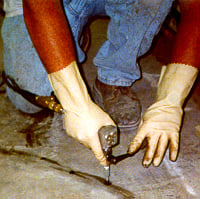Do you always consider alternative porting methods as you prepare to execute an epoxy crack...
Concrete crack hiding magic tips (after epoxy injection)
Can you make epoxy injection repaired cracks in concrete disappear? This is a difficult challenge, but you can take steps to reduce their visibility. In some cases, cracks can be made almost invisible.
Architectural precast and GFRC panel manufacturers as well as many concrete repair contractors have developed several techniques to hide cracks if a new surface coating is not the answer.
If the localized area around the crack is stained from water leaks, dirt deposits, white crystalline deposits (also called efflorescence), high pressure water blasting (5000 psi) or light sandblasting might be the first thing to try. Be careful to avoid altering the surface texture or exposing the aggregate below the surface paste.

An alternative stain removal procedure is to use a mild acid micro etch applied on the concrete surface. Although there are proprietary products formulated for this purpose, some specialists swear by a combination of warm dilute acetic acid (vinegar) and 1 % dish soap. This homemade solution can be sponged and scrubbed into the surface, allowed to soak and then rinse off.
Assuming the crack requires epoxy injection for a structural or water leakage issue, be sure to special order a non-tinted clear resin/hardener combination from us. Normally, our part B (hardener) of the epoxy injection resins is slightly tinted to help provide visual evidence that both components are delivered in proper proportions by the metering pump during crack injection.

ChemCo Systems StripSEAL™ is a great choice for a peelable (easily removed) surface seal (also called a capseal). It cures very quickly and readily strips without leaving a residue. Occasionally, there may be a slight darkening of light surfaces—this can be fixed with a light application of dilute acetic acid as described above.
If the substrate is ivory white, this can be challenging to repair and hide cracks even with the talents of experienced pro experts. We've got some great secrets to share as a solution but you'll need to call us to discuss.

In concrete crack repair projects where appearance and aesthetics are especially critical, you can try a modified dry sack technique. First, you will need to locate some of the smaller (fine) aggregate (suggested max. size 40-50 mesh) used in the original concrete mix or a similarly colored facsimile. Strip the epoxy surface seal no more than 30 minutes after the injection resin has gelled (long before cure, but while the epoxy is still tacky). Then take a small burlap sack filled with a blend of the small (fine) aggregate and dust the area of the crack until the still tacky glue line is covered. Optionally, the dry aggregate can be scrubbed over the surface using a soft sponge rubber float. The fine aggregate should match the color of the surface and fill in the shadow of the crack as the fine grains are held in place by the still tacky epoxy. If the crack is relatively wide (you be the judge), you can pre-place a strip of 1/4” masking tape completely over the whole crack before sealing with StripSEAL. You can get the tape from professional paint supply stores. This prevents the StripSEAL from penetrating deeper into the crack walls and allows the pumped in injection resin to
 fill to the level of the surface. This minimizes the daylight shadow created by the indented seal. If masking tape is used, you will have to puncture it at the locations of each surface port in order to connect with the crack.
fill to the level of the surface. This minimizes the daylight shadow created by the indented seal. If masking tape is used, you will have to puncture it at the locations of each surface port in order to connect with the crack.
For large areas, or surfaces with other defects including bug holes, it may be more convenient to use a wet sacking mix which contains Portland cement, fine aggregates and other admixtures similar to the constituents of the original concrete finish. If the crack can be masked on both sides, then it is easier to prevent the water-wetted area to be repaired from extending far past the crack edges. Prior to performing this type of repair, it is highly recommended to practice on a small mock-up or on a crack in a non-visible location.
For more help, call us at ChemCo Systems (800-757-6773, 650-261-3790).



